25 July 2007, 23:00
LoneduckBuff and plains game with Alan Shearing and CM Safaris, July 2007
My wife, Diann, and I returned from a 12-day buffalo, sable, and plains game safari on July 15. This report is essentially a diary of our trip and, thus, is probably unnecessarily verbose. Therefore, just skip the uninteresting parts and keep in mind that we are first-time travelers to Africa and that I am not a highly experienced big game hunter. I expect that the report will be of more interest to other safari novices like myself rather than the many experienced individuals who inhabit this forum. Anyway, here goes!Dates: July 2-13, 2007
Location: Zimbabwe - Makuti Safari Area and three ranches near Kwekwe
Safari company: Charlton McCallum Safaris
PH, trackers, and cameraman: Alan Shearing, Takavarasha, Naison, Ian Rogers
Species sought: Buffalo, sable, kudu, bushbuck, impala
Rifles and loads: CZ 550, 375 H&H, handloads of Barnes 300-gr. TSX & banded solids @ 2550 fps; Browning FN Mauser, 30-06, handload of Barnes 180-gr. TSX @ 2690 fps
Thursday, June 28 – Friday, June 29
The ticket agent would not check the gun case through to Jo’berg, saying we had to pick it up and have the Port Authority transfer it to SAA. She also said that the Tuffpak wasn’t a gun case and that SAA wouldn’t take it. All BS!
In Washington DC, the gun case did not show up on the baggage carousel, but I found it in the oversize baggage area. We took it to SAA (where we found a huge crowd) and then to TSA. The last I saw of it, it was sitting in the TSA security area after going through their x-ray machine.
In Jo'berg, it took about 2 hr. to get out of the airport, even with the Rifle Permits staff greatly facilitated our way through customs and the pre-approved firearms permit process. The firearms permit office was backed up because three different flights arrived in Jo’berg from the US at about the same time.
Louis, from Afton House, picked us and other couples up and took all but 1 couple and their children to Eland House for the night – not Afton House, where we had made reservations through Susan Hill of Gracy Travel. (As an aside, the trip planning and final itinerary were all handled very professionally by Susan.)
Eland House was unheated (which I guess is the norm in Jo’berg) and the light in our bathroom did not work. Mike, the proprietor could not fix it, so he gave us a battery-powered fluorescent light to use. We decided against a shower in the dim light. I took an Ambien (for the first time ever) and slept pretty well.
Saturday, June 30
Louis picked us up @ 0730 and we went by Afton House to pay our bill of R1750, which apparently consisted of meet and greet, pre-approved firearms permits, and overnight stay at Eland House. I thought meet and greet was included with the overnight stay, but apparently only if you actually stay at Afton House!
When we arrived at the airport, Bruce escorted us through flight and firearms check in. He was very helpful, as he had been on our arrival the day before.
We were a little late into Harare, where we found a long line to go through customs with the guns. This was after our luggage finally arrived on the carousel and our gun case was brought up separately to the luggage-claim area.
Carla, from Charlton McCallum Safaris met Diann and me while we were waiting to get through customs and facilitated that process. We were very glad to see her! She drove us to the Wild Geese Lodge, where we would spend the night and where we would meet Alan Shearing, our PH, and Ian Rogers, our cameraman, for dinner that night. The overnight stay was originally unplanned, but a few days before we left for Zim, Carla informed us that a scheduling conflict with Alan (she claimed she was to blame, but that’s unimportant) meant that we needed to spend Saturday night in Harare and drive with Alan to Makuti on Sunday morning; our hunt would start on Monday, 7/2. We were originally scheduled (as stated in our contract) to drive to Makuti on Saturday afternoon after our arrival in Harare and start hunting on Sunday, 7/1. Thus, we lost a day of hunting.
This caused a little financial misunderstanding, as we were originally scheduled for 12 days of hunting and a transfer day (at observer, not hunting, rates) to move from Makuti to Kwekwe. Instead, we were charged for 12 hunting days, with the moving day considered a hunting, rather than transfer, day. Needless to say, we weren’t too happy about this change.
Harare – and the rest of Zimbabwe, as we later found – is filled with people who, apparently due to high unemployment, seem to have nothing to do. We saw them walking along roads and in any open space. Armed army personnel were stationed at intervals along the road form the airport into the city. As we found out later, this was because the Vice President was to arrive that day. Corn was planted in every available place in a completely unregulated manner. It appears to be “every man and woman for themselves†when it comes to obtaining whatever food they can.
The Wild Geese Lodge is in a park-like setting amid numerous small trees and some large acacias and morondas. Name tags on some of the trees allow guests to identify them.
At the lodge, the only other guests were a couple – John and Kathy – from the Karanda Missionary Hospital, who were originally from the US before coming to Zimbabwe.
We walked around the Wild Geese compound before sunset and saw the zebras in the adjacent “game park†owned by the owner of Ingwe Safaris
We had dinner with Alan and Ian @1900. Both made a very pleasant first impressions and we seemed to get along well. They will pick us up tomorrow at about 0800.
Sunday, July 1
We drove from Harare to Chemakunguwo Camp in the Makuti safari area and arrived at about 1230. The Land Cruiser was stuffed with our luggage, provisions for camp, Alan, Ian, and trackers Taka and Naison, as well as some of their personal goods. Charles Helm and Yukon Delta have posted several photos of this camp in earlier posts, so I have not included any here.
We found that we were sharing the camp with Brian from Phoenix AZ, who had killed a good leopard, buffalo, and elephant (and had to shoot a young elephant bull who charged unexpectedly from about 30 yds.). Myles was his PH and they were leaving in a couple days for Chewore, where Brian would try for a hippo. The camp manager and apprentice PH, Guy Ferreira, was also serving as their cameraman.
Also in camp were Buzz and his client Marius, from South Africa, who killed a good leopard practically in camp that morning, then got a very good buffalo about the time we arrived. That’s a pretty spectacular hunting day! This was on about the 4th day of his 24-day safari that was also to include a lion and elephant bull. Ryan Cox was their cameraman.
We ate lunch and then went to the Parks and Wildlife office in Morangoro to pick up John, our game scout, who would be with us for the duration of our stay in Makuti. On the way, we saw our first elephants in some long grass. The grass was so tall that I got the incorrect impression that the elephants were lying down. It’s obvious why hunting them under those conditions is so dangerous!
Just before sunset, we checked the rifles at about 70 yds. and found both to still shoot where they were aimed.
Monday, July 2
Temperature: 43, 88F; partly cloudy; variable wind: 5-15.
We got up at 0500 and left camp at about 0630. I slept poorly, even with Ambien – maybe residual jet lag.
We headed to the lower part (down the Kariba Rd.) of the concession to check it out before the safari operator (Ian Gloss) that shares the concession starts hunting there on Tuesday.
We found fresh buffalo dung on the tarred Kariba Rd., which forms the concession boundary. Tracking revealed that the buffalo had recrossed the road off of Makuti and were not huntable.
After we continued driving, the trackers spotted a lone buffalo bull on the right (Makuti) side of the road, but Alan determined it was not good enough to try for on the 1st day of the hunt.
We found lion tracks at 3 locations and, at the last location, they seem to have chased the buffalo out of the area.
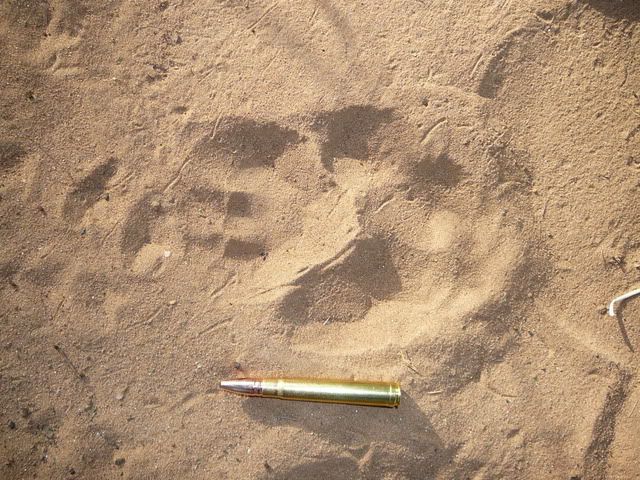
Lion track with a 375 H&H cartridge for comparison
On the way back on the Kariba Rd. in the afternoon, we spotted a herd of sable, but there was no bull, only a deceptively long-horned cow. We saw another herd of sable along the road, but they were on the “wrong†(non-Makuti) side of the road. There was a decent bull in that group.
Finally, we spotted a herd of about a dozen buffalo - with a shootable bull - near the road, but again on the wrong side. This may have been the same herd that we tracked along the Makuti side road in the morning, before they crossed to the other side. They were bedded and although we waited and watched for a long time, they never moved or did anything that suggested they would cross the road anytime soon, so we moved on and returned to camp.
Other notable observations that day included a young elephant bull below a bend in the Kariba Rd. and a kudu cow and calf along the same road, the only kudu we saw in 5 days of hunting in Makuti. We (I) got a pretty good look at a small, spotted, short-tailed cat (about the size of a thin house cat) in a grassy area as we drove along a dirt road. The only thing I could find that it resembled was a black-footed cat, but that’s nearly impossible, as they don’t occur in this area and are almost strictly nocturnal.
Tuesday, July 3
Temperature extremes: 48, 71F; mostly cloudy, wind: 5-15 mph.
We turned right off the road into camp to check out the area where Buzz and Marius killed the big buffalo on Sunday. We saw many buffalo tracks on the road and then spotted a small herd on the left. They moved off and we turned around, went back down the road, and started off on a course designed to intercept them. We came at the herd from an angle with a generally favorable wind direction; we could hear them, but not see them. As there was a “herd†of us also (Taka, Alan, me, Diann, Ian, Naison, and John!), they sensed our presence by either seeing or hearing us and ran off a distance, and then spooked completely into the bush. Alan said he saw no shootable bulls. Neither did I, but that doesn’t mean anything.
We then drove to the Ruyese R. valley, where the trackers checked a lion bait for Buzz and encountered a hyena at about 20 yds. We drove to the end of the road and walked upriver following old sign of a buffalo herd that was known to be using the valley. We soon found fresher sign and Alan said we had quickly made up 24 hrs. on the herd. Shortly, Naison spotted a cow and we carefully worked our way into position to see much of the herd. We watched the show from about 120 yds. across the river bed from about 1100 to 1445, waiting for them to get up and start grazing and also looking for a good bull. Alan estimated there were 100-150 animals in the herd, with a large proportion of bulls. Although many were quite wide with deep curls, most were also immature. Upon, my questioning, Alan assured me that he wouldn’t allow me to shoot from such a long distance unless a really outstanding bull appeared in the herd. I was relieved, because I wanted to be much closer for my first buffalo.
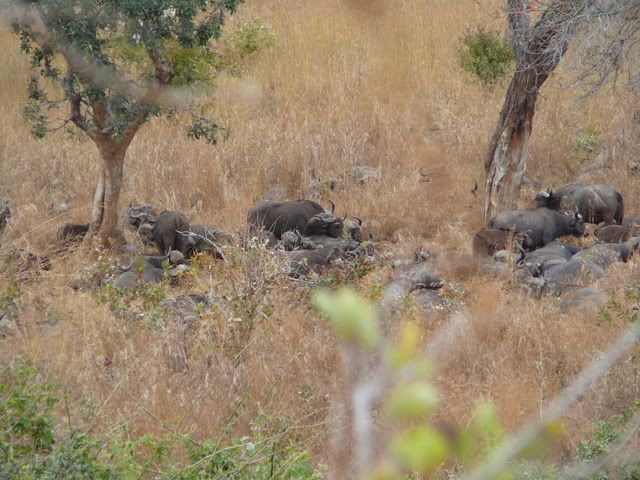
The bedded buffalo herd as seen from our vantage point across the river
While we were watching, a young elephant bull walked over the hill and approached the resting buffalo herd. We thought he might disturb them, but he passed by and went into the river bed. He was in musth, as evidenced by the noticeable temporal gland discharge, and Alan was concerned that if he got behind and downwind of us, he could be trouble. Shortly, he came back out of the river bed, passed by the buffalo herd again, and crossed the river to our side. The concern about him getting our scent remained, but we never saw him again.
As the herd started to get restless – and we spotted a couple bulls in the river bed that we may not have seen before – we started to sneak upstream to get a better look at those bulls and to get in better position to intercept the herd of it continued its upstream grazing pattern. The bulls in the river bed proved to be nothing exceptional, but Alan had spotted shootable bulls in the herd, one with a very wide boss. We moved into position upstream of the herd and close to the river bank as they started to feed along the opposite bank. The wide-bossed bull followed another behind some brush and then one of them walked into the open about 20-30 yds. away. I thought it was the first, smaller bull, but Alan said, “Don’t you want that one?†I realized they had changed places and quickly shot just behind the shoulder. The bull turned and lumbered uphill quartering away. I shot twice more before he lost steam and turned left across the slope to offer a crossing shot. I fired twice more and knocked him down with the last shot, although he appeared almost ready to fall over just before I shot. My gun was empty and the bull was down. His death bellow – actually, several of them – followed shortly thereafter. Alan had shot once with his open-sighted 458 Win. right after my 3rd shot, but thought he had missed. Examination then and when the bull was skinned showed that I had hit him at least 4 times, the original shot with a Barnes 300 gr. TSX that left a fist-sized hole in the heart and exited, 2 Barnes 300 gr. banded solids that entered the left hip and passed through the entire length of the body (one of these exited on the opposite shoulder, the other was in the skin of the neck and was the only bullet recovered), and my last shot with a solid than knocked him down. One of the solids also passed through the heart. Alan was astonished that my solids had penetrated the entire length of the buffalo and that one of them had even exited.
I’m pretty ignorant about buffalo trophy quality; he’s pretty wide bossed, but doesn’t have much width or a very deep curl. Alan seemed pleased with him when we approached and said to either the trackers or no one in particular “Dugga boy!†I’ll admit, he did have a little dried mud on his rump!
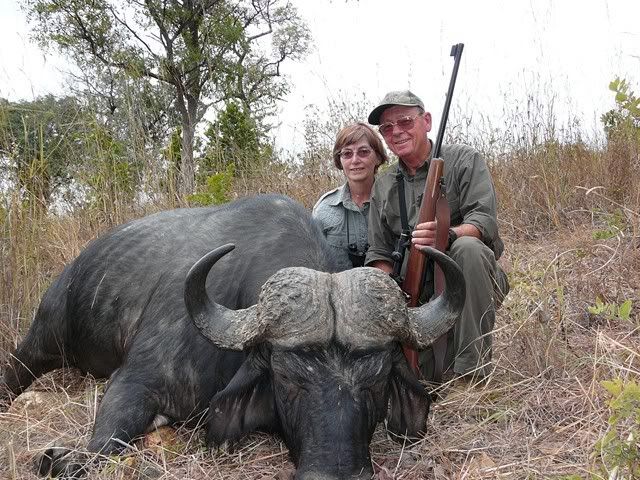
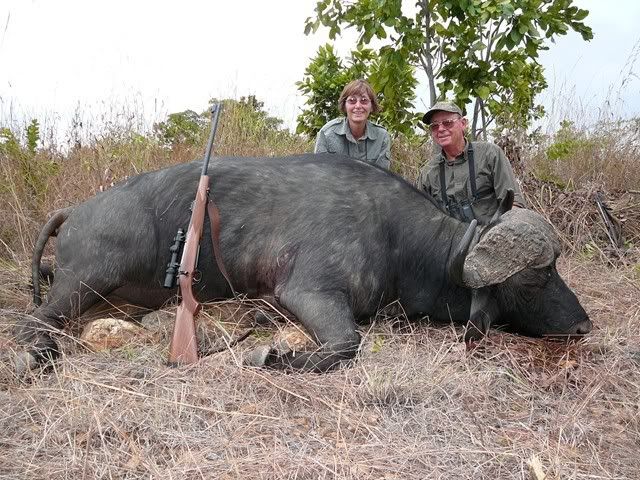
Diann and I with my buffalo
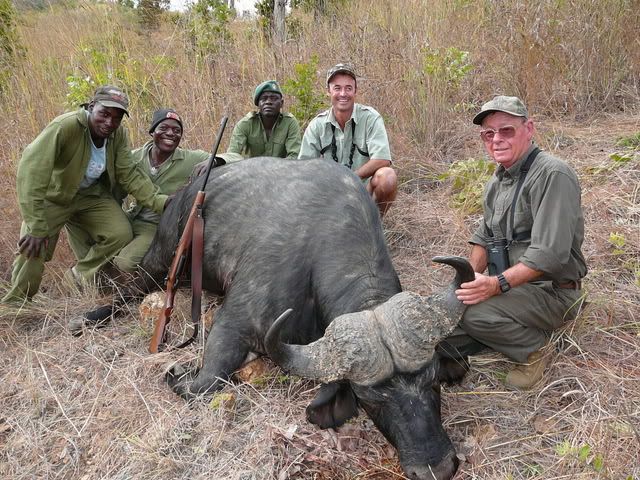
From the left, Naison, Taka, John, Alan, and me with my buffalo
Ian got excellent video of all this, including the herd, the elephant, and the shooting of the bull. The PHs and other hunters in camp that night that saw the video gave him the nickname “Spielbergâ€, although that name wouldn’t last as we progressed through my plains game hunting and his tendency to flinch at the shot became more apparent.
The bull was 2.5 km (1.5 miles) straight-line distance from the cruiser, so we planned a recovery for the next morning.
Today is Buzz’s 34th birthday, so camp staff prepared a cake for him and serenaded him as they brought the cake out after dinner. He seemed to take his 34th pretty hard. If we had known, we could have brought him some Viagra to help him through his dotage.
Wednesday, July 4
Temperature 46, 69F; mostly cloudy again, wind: 5-15 again.
We – I should say Alan, Guy, trackers, camp staff, and Ian – recovered the buffalo this morning. Diann and I were fairly useless! We left camp at about 0600 and returned with the bull – cut in half – about 1330. They were able to cut a road to get the cruiser all the way to the bull, including three river crossings and lots of brush cutting – all this without any sophisticated tools, just what I would describe as axes and mattocks.
On the way to get the buffalo, we saw a sable herd with a really good bull. At least I thought it was a very good bull; Alan didn’t seem as enthusiastic about it as I, but maybe he was trying to soften the blow of how things turned out. While Guy and camp staff continued on the start the recovery process, we detoured to track the sable. After only a few hundred yards, Alan motioned for the rest of us to stop while he and Taka went forward. Well, I’m sad to say that I took this opportunity to take a leak, which I should have done when we got out of the truck. BIG MISTAKE!While I was not paying attention, Alan and Taka spotted the sable at about 100 yds. By the time they got my attention (John grabbed my sleeve), the bull was at least 200 yds. away and facing away and uphill. He turned to the right behind a bush, the stepped out briefly before disappearing into some cover, never to be seen again. All this time, I was on the sticks, but very unsteady with the 375 and just was not comfortable with the shot. I couldn’t pick a spot to shoot and did not want to just shoot at the “whole animal,†a recipe for disaster. When this was all over, I was beyond despondent and disappointed in myself. I felt that I may have blown my only chance for a sable and that if I did get another chance, it was unlikely to be at such a nice animal. I took me about 6 days to get over this!
To add insult to injury, Buzz and Marius returned to camp shortly after us with a sable shot in the same vicinity as where I blew my chance. It probably wasn’t the same one, as Marius’ was with another, smaller bull, not with a herd.
We went back out and hunted kudu and sable late in the afternoon. We saw nothing but some guineafowl and I killed two of them with Buzz’s shotgun and some Eley #7-1/2 target loads. Small consolation for my lost sable.
My sore throat that started on Monday mid-morning became worse. It and the soon-to-develop runny nose, cough, and laryngitis plagued me for the rest of the hunt and even for a little while after our return home.
Thursday, July 5
Temperature: 41, 71F; mostly clear – finally; wind: 5-10 mph.
We went down to Marongora this morning to look for waterbuck, kudu, and bushbuck. We saw two small waterbuck bulls just off the paved road. We took a walk in long grass and riparian areas hoping to see something or find some fresh sign, but saw nothing interesting accept a pair of honey badgers.
After returning to camp for lunch, we went out again about 1430. We saw several elephants and a female grysbok; at least that’s what Alan said it was – I only saw a small, grey antelope bounding into cover. One cow elephant with a young calf mock-charged the cruiser, but she was far enough away that there didn’t seem to be any cause for concern. We found no more guineafowl and the two I got yesterday are hardly enough to feed the camp.
Friday, July 6
Temperature 40, 72F; mostly clear, but partly cloudy in the late PM; wind: 5-10 mph.
We heard hyenas during the night. Marius said he heard a lion, but we didn’t. A female leopard hangs around camp and is heard frequently at night.
We went back to the Ruyese R., hoping to see some sable on the way down, but saw none. We walked through a beautiful riparian area created by a large spring. The flow of water was sufficient to create a small waterfall in one location. We saw nothing on this walk, but, again, there were lots of us and we probably made a lot of noise and generated a lot of scent. We did find vines with “lucky beans†on them. I pocketed some and kept my fingers crossed, to no avail, at least at the moment.
We returned to camp for lunch and then took our game scout John back to his home and completed the paperwork for our hunt in Makuti at the Parks and Wildlife office. That was the end our hunt in Makuti.
Saturday, July 7
After saying goodbye and thanking everyone in Chemakunguwo Camp, we headed for the Kwekwe plains game ranches shortly before 0700. We arrived about 1300 after a long drive. Most of our driving time, both on tarred roads and when hunting on dirt roads, is spent with Alan, Diann, and me in the cab of the cruiser and Taka, Naison, and Ian in the back. It’s a little cozy and uncomfortable for us and just about freezing cold for those in the back for the first couple hours in the morning.
On the way, we met Royal north of Karoi and got a barrel with 200 liters of diesel to fuel the cruiser and some wine, gin, and scotch to fuel us.
Our camp for the next 7 days would be on the Chinyika Ranch, an anomaly in Zimbabwe, as it is still owned by a white rancher, Ken King. The other ranches we would hunt are Pitscottie (sable only), and Circle G. Circle G was owned by Alan’s grandfather before the war veterans appropriated it and Alan grew up there. He had many stories to tell of his childhood there and I’m sure his return to the Kwekwe area is always bittersweet.
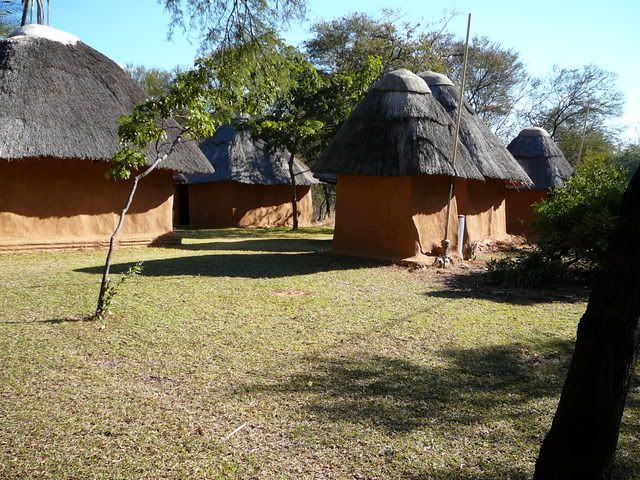
Chinyika Camp cabins, showers, and toilets; traditional pole and mud constuction with thatch roofs
We had lunch and relaxed for the rest of the day. In the evening we met Graham and his son from Cairns, Australia, where he is a marlin fishing guide, and their PH, Owen. Graham was hunting leopard – unfortunately, unsuccessfully – and his son had killed several plains game species. This was their last day. We also met Keith Pilz, who has been working with rhino in the Midlands Black Rhino Conservancy, of which Pitscottie, Chinyika, and Circle G are a part. His studies include tagging rhinos, but that is impossible now, as the transmitters are placed in the horns and the horns of all the rhinos in the conservancy have been removed to discourage poaching. Unfortunately, this hasn’t worked, as the poachers continue to kill dehorned rhinos either for the little horn they have left or so they won’t waste time in tracking a dehorned rhino again. After an increase in abundance during the 1990s, the rhino population in the conservancy has declined by over half in the last 5 or 6 years, so that only 29 animals are known to exist there now. In spite of effort by people like Keith, things don’t look good for the rhinos’ future.
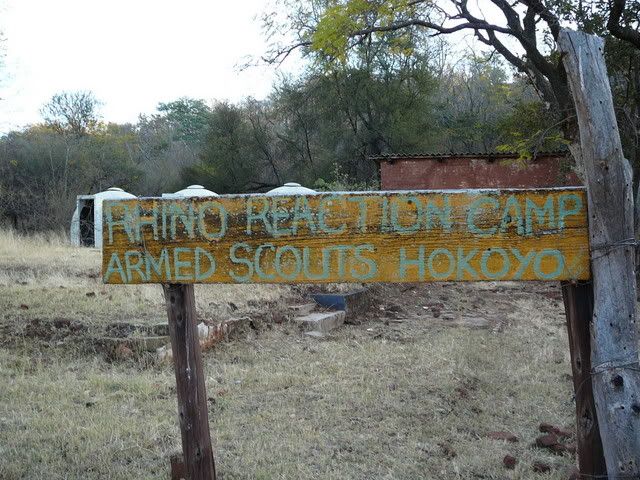
A sign at the site of an abandoned anti-rhino-poaching camp on the Chinyika Ranch
An interesting geographic feature of Zimbabwe is the Great Dike, a mineral-rich upthrusted area that runs almost N-S (actually, about 10 degrees E of N) through the country for about 300 miles. We drove over it on the way from Harare to Makuti and both Chinyika and Circle G contain some of it within their boundaries. On the ground, it appears as a wide range of hills. We saw several abandoned chromium mines in the hills on Circle G and a huge platinum mine on the drive back to Harare at the end of our hunt.
Sunday, July 8
Temperature: 46, 75; clear; light wind: 0-10 mph.
We hunted sable on Pitscottie in the morning. Besides our normal trackers, we picked up Nyati, the head scout on Chinyika, and a scout from Pitscottie, who must accompany us while we hunt that ranch. Thus, there are 8 of us in the cruiser. Nyati is very helpful in identifying birds and vegetation. Alan said he has learned the English and scientific names of at least 100 species of trees that occur in the area.
We saw a herd of young sable before we got to the Pitscottie headquarters, which sits in a beautiful setting on the bank of the Munyati R. and is one boundary of the ranch. This was the camp that CM Safaris used last year, but new owners of the ranch had planned to turn it into a photographic-safari-only area and availability of the ranch accommodations was uncertain, so CM is using the Chinyika camp this year.
We saw no more sable, although we found and followed tracks of a herd and a pair of bulls from yesterday or last night.
We returned to camp about 1300 for lunch after picking up Naison’s wife (he lives across the Munyati R. and stopping at a camp near a dam on the Circle G to talk to Zimoto, a scout who had told Buzz about a waterbuck bull that frequents one of the dams in the late afternoon. It turned out that the bull hadn’t been seen in awhile.
An afternoon kudu hunt was unsuccessful.
Alan’s wife, Rosy, and son, Kyle, had come to Chinyika the day before and they had dinner with us Sunday and Monday evenings. It was enjoyable to talk to her and discover all the pop culture similarities between southern Africa and the US – same TV shows, movies, and music.
As an aside, we talked about the post on the AR forum by Yukon Delta concerning his elephant hunt with Alan in early June. Yukon Delta compared Alan’s appearance to that of the actor Leonardo DiCaprio, much to Alan’s embarrassment. I suggested that Alan more closely resembled another actor, Andy Garcia. Rosy and Diann agreed, again to Alan’s embarrassment.
Monday, July 9
Temperature: 48, 72; mostly clear; wind: 10-15 mph.
In the morning we went to Pitscottie again for sable and saw a rhino bull cross the road on the way in – 1/29th of the rhino remaining in the conservancy. We then found an injured zebra with a broken femur along the road. It was very stressed by our presence. After receiving approval from the Pitscottie assistant manager, we returned and shot the zebra to end its suffering. Backtracking it, it was obvious that it had been injured for several days, probably in a fight with another zebra. The broken leg and adjacent abdomen were becoming infected. We took the zebra to the ranch headquarters, where part of it was to be salvaged for the meat.
We then drove the roads – and “barely†roads – for much of the day without seeing any sable (except for the group of young animals we had seen the day before) or any fresh sign.
Later in the afternoon we returned to Chinyika to look for kudu and impala. We saw a group of 3 eland bulls and then a mixed herd of wildebeest and zebra. Shortly after, near a rocky hill, we saw a shootable kudu bull. He ran up the hill as I got the rifle and Alan set up the sticks. I couldn’t see his body at that point, only the tops of his horns. He moved and I lost sight of him. He came into Alan’s view, but I couldn’t see him. Alan was fairly frantic, trying to get me to see the bull, which to him was obvious and to me was invisible. We finally agreed that the bull was on top of a black rock and that his shoulder was bisected by a small branch the extended from the lower right to the upper left and that he was facing to the right. Once I finally believed that what I saw was a kudu’s chest and flank and not a brownish-grey rock, I quickly held behind the shoulder and shot. Recoil prevented me from seeing what happened – and Ian flinched badly and only recorded trees and sky – but Alan said the bull bucked like a horse, reared up, and spun 180 degrees before running to our left. We waited a couple minutes and saw a small herd of kudu cows and calves run off from the area to which the bull had gone. We walked up the hill, but found no blood. However, Ian found him dead from a lung shot about 40 yds. from where he was when hit. He appeared to be an old bull, with many scars on his neck and shoulders, but his horns probably aren’t even 50 inches. Still, he’s my first, and probably only, kudu.
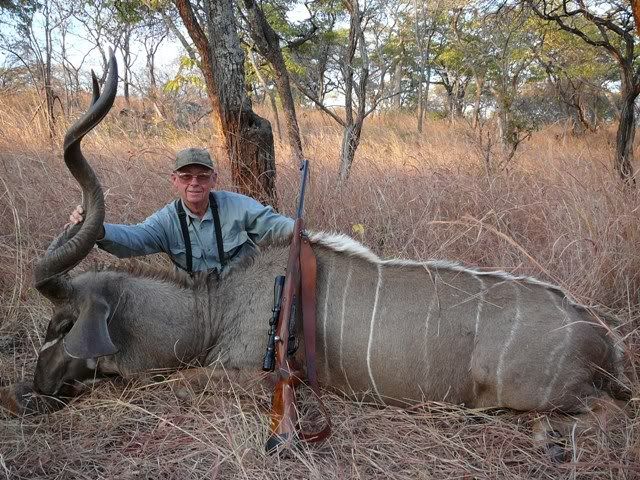
My kudu

Diann and I with my kudu
Tuesday, July 10
Temperature 47, 72F; clear; strong 15-20 mph wind.
We hunted the Circle G in the morning for sable, driving to all the likely spots and climbing a hill to look over a bunch of country on the Great Dike. We saw no sable or any fresh sable sign. What little sign there was appeared to be about a week old. My failure to get the sable on Makuti was really starting to appear to be a jinx!
We saw impala, zebra, and wildebeest, but most game seemed to be hiding out of the wind, which is a leftover from a storm that hit South Africa a day or two ago.
We returned to camp for lunch and went out again about 1500 to look for impala on Chinyika, as scouts on Pitscottie didn’t find any fresh sable sign. We were unsuccessful.
Wednesday, July 11
Temperature 41, 74; clear; swirling 0-15 mph wind.
We went to Pitscottie looking for sable and drove the road along the Munyati R., where we saw nothing. After leaving the river, we found fresh tracks of a herd of sable. As we started to follow them, we saw two big eland bulls in a vlei, accompanied by a lone zebra. We continued to track the sable and lost the track for quite a while at one point. When Alan re-acquired the track, we were able to follow it pretty quickly. I had no idea exactly what was going on, other than that we were tracking a herd of sable and that the bull had left the herd at one point. We started the tracking between 0815 and 0830 and about 1115 we stopped to rest. This ½-hr. break was really designed to let the sable calm down, as Alan finally explained that they were aware they were being followed – alerted by sound (remember, there were 8 of us) and scent, because the wind was swirling and often on the back of my neck. Also, Alan explained that a herd of zebra had been with the sable until shortly before we stopped, when we saw them run off to the left.
About 1200, after about 4 hrs. of tracking, we reached the main road and 6 of us remained there while Nyati and the Pitscottie scout returned 2.7 km for the truck.
When the truck arrived, we ate lunch and then started driving on roads that might intersect the sables’ path. That way they might settle down without the constant presence of our scent and sound, although the cruiser wasn’t exactly quiet. The only sign we saw doing this was some old sable tacks.
Shortly after finding those tracks, the trackers spotted the sable herd in the bush about 130-150 yds. from the road. Most ran off after the bull presented a broadside shot for an instant, but before I had the rifle loaded and ready to go. I saw that one cow remained behind, but didn’t see that the bull returned. Alan did and pointed it out to me. Not unexpectedly, Alan was very tense at this point, as I had demonstrated time and again that I wasn’t the best game spotter he had ever met (a huge understatement!). He told me to turn the scope up to 9X to see better through the brush and that allowed me to see the bull’s orientation (quartering towards me) and that I had a clear shot, unobstructed by any brush. I aimed for the left shoulder and heard the bullet hit with a loud “whaap,†which made me a little concerned that I had hit too far back. Not to worry because, as we walked the 150 yds. to where the bull had been standing when I shot, we spotted him lying about 40-50 yards beyond that point. Alan was very excited and ran towards the bull, but Taka seemed to arrive at the same time. To my great surprise, Alan leaped into Taka’s arms to allow Taka to carry him around for a few seconds. As can be imagined, there was much excitement, many congratulatory handshakes, and lots of pictures. Alan stated that it was one of the best sable hunts he had experienced, and I believed him after seeing the reaction of everybody to our success.
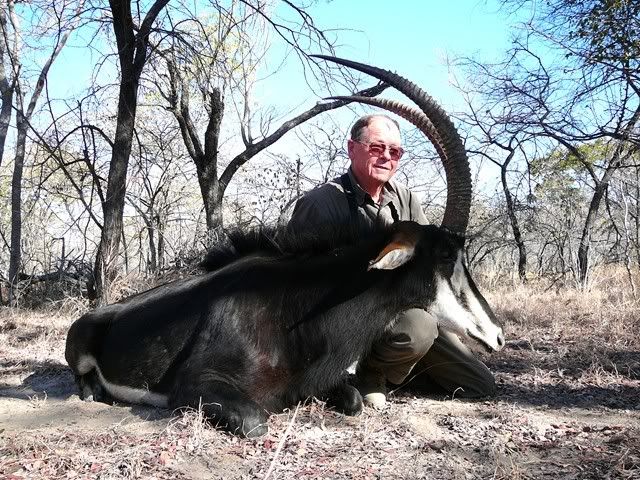
My sable
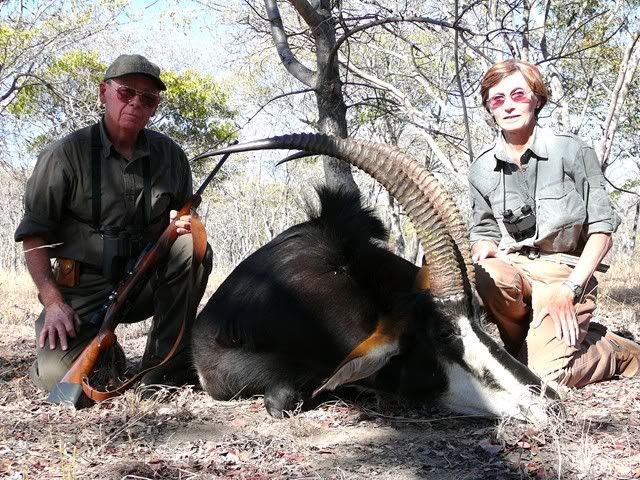
Diann and me with my sable
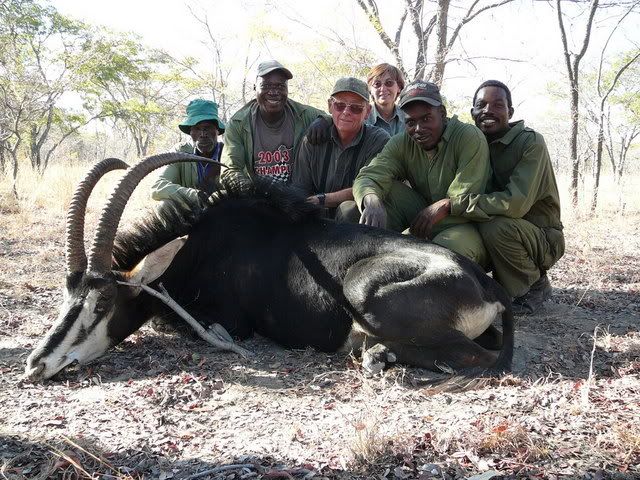
From the left, the Pitscottie scout, Taka, me, Diann, Naison, and Nyati with my sable
We took the sable to the Pitscottie headquarters for skinning and returned with the cape and head to Chinyika after sunset. On our way, we of course saw both a shootable sable bull and kudu bull. That was to be the only shootable kudu bull we saw, other than the one I killed.
Thursday, July 12
Temperature 46, 76F; clear with some cirrus; wind: 0-5.
How to go from sable hero to impala goat in less than 24 hrs!? Here’s how.
We went looking for an impala on Chinyika in the morning and shortly found a suitable ram. He ran off a ways and stopped to look back, presenting an easy broadside shot. I wobbled around on the sticks and missed him cleanly by shooting in front of the shoulder. It was so obvious to everyone that I missed that we didn’t even go look for blood. I was too nonchalant and didn’t concentrate. As I hadn’t missed up to then, I must have thought I was charmed and that close was good enough! Also, I think it was in the back of my mind that I didn’t really like the looks of that ram’s horns: they pointed in at the tips and I hoped to get one with parallel horn tips. Silly, I know; if I didn’t really want that animal, why did I shoot?
As a further insult, I missed 5 shots at guineafowl; it felt like I was shooting blanks. So now I’m 0 for 6 on game that day!
In the afternoon, we saw few impala, but did see a really good ram accompanied by three other rams. They, of course, ran into some thornbush and started snorting at us as we slowly moved forward, trying to get a look at them. At least I was trying to see them; Alan had no trouble making them out and even was able to tell which was the good one. He finally was able to point the good ram out to me just over the top of a low termite mound. I couldn’t see it with the naked eye, but through the scope it appeared like a tan and white ghost in the grey mist of the thornbush. It was facing me and I could see its head, neck, and upper half of the chest. I had to shoot from my knees in order to see it, so I grasped the sticks with my left hand and rested the rifle on my left wrist. I felt good when the gun went off, but there was no sign that I hit him. Two of the rams ran to the right, whereas my ram and another ran to the left. Alan and I followed and caught glimpses of them, but never enough for a shot. We gave up when it became too dark to see and returned to camp.
A wonderful day: 7 total misses, 2 on impala and 5 on guineafowl! It was like I had never done this before. It’s said that if you’ve never missed, you’ve not hunted much, but this was ridiculous!
Friday, July 13
Temperature: 46, 76F; some high, thin clouds; very windy after about 1000.
My last hunting day started off by finding the same group of four impala containing the ram I missed the evening before. They were in almost exactly the same place and pulled the same disappearing act in thorn and long grass as previously, without giving us a shot.
A little later we spotted (actually, I spotted – at least as soon as everyone else) a group of impala in the same general area as I missed the ram the morning before. This was another group of four rams about 200 yds. away. Alan said one was very good and pointed him out when he turned broadside. I couldn’t see his belly line because of the brush, but his back line and most of his side were visible. Off the sticks I hit him high just under the spine. He dropped where he stood. Alan said he was the best ram taken off those ranches in the last several years, maybe 22 inches. This may have been said only to make me feel better about getting a ram after my misses of the previous day, but I was pretty happy with him.
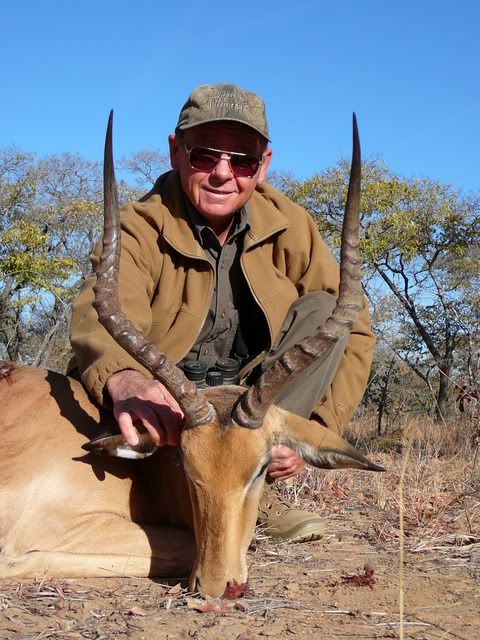
My impala
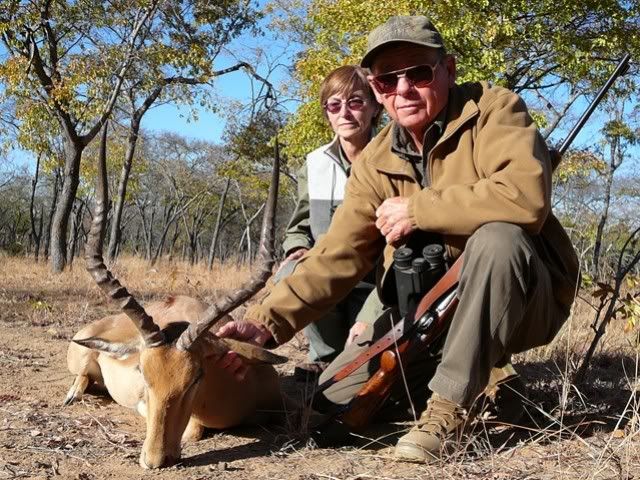
Diann and me with my impala
When we dropped the impala off for skinning, the Chinyika Ranch owner asked us to try to kill any old wildebeest bulls we could find in unproductive herds – those with no calves. His motivation was two-fold: to increase calf production in those herds and to provide meat for his ranch workers. Harvesting bulls from a wildebeest herd in miombo woodland is easier said than done, especially when trying to stalk them with an entourage of people. We tried, but we failed and returned to camp for lunch.
As we headed out in the very windy afternoon to look for more wildebeest, the owner radioed a request for a meat zebra, as we had such poor luck with the wildebeest. Animals were jumpy and in heavy cover in the wind, but we finally came across a single zebra. At the shot, he wheeled 180 degrees and ran frantically, while the bush exploded with impala that I hadn’t even seen until then. After this was all sorted out, we found the zebra about 50 yds. from where it had been shot. He was an old stallion.
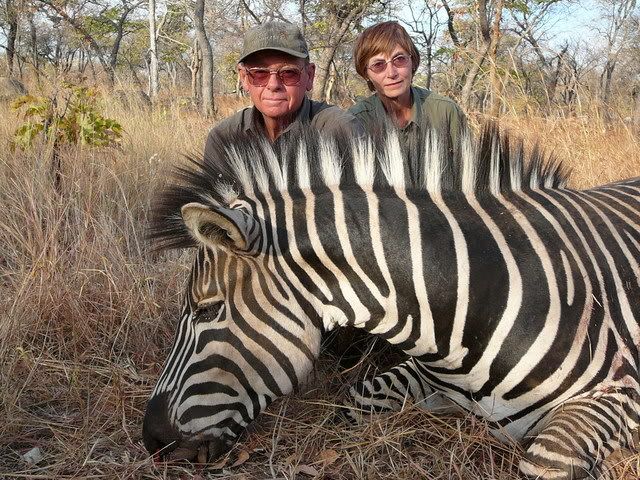
Diann and me with the zebra
Saturday, July 14 - Sunday, July 15
This was the day we headed home. We packed up and headed for Harare a little after 0600. We took the “back way†at first, traveling the first 67 km on dirt and gravel roads before hitting tar. Two highlights were cow and calf rhinos that crossed the road twice in front of us and the sandy, rocky crossing of the Munyati R. on what was only vaguely a road.
We entered Harare from the south (I think), and drove through the center of the city and on to Buzz’s house, where we offloaded most of the goods from the cruiser, had tea, said goodbye and thank you to everyone but Alan, and proceeded to the airport. Alan made sure we got through the minimal red tape at the airport and we were on our way home.
The highlight of the long series of flights back to Sacramento was the way we were treated by Customs, the airline personnel, a Port Authority officer, and TSA personnel at JFK in New York. They were all very friendly, inquiring about our hunting success, and helpful in getting the gun case processed and onto United Airlines – I’m not kidding, this is true.
We, and all our luggage, arrived safe and sound in Sacramento late Sunday afternoon.
What we saw
To save space (which actually isn’t at a premium, given my long-windedness), I haven’t consistently listed the animal species we saw in each day’s account. So here is a summary:
Mammals: Oribi, vervet monkey, baboon, warthog, common duiker, reedbuck, grysbok, steenbok, Cape or southern buffalo, elephant, sable, southern greater kudu, zebra, small spotted cat with short tail(?), impala, black rhino, giraffe, wildebeest (grey?), bushbuck, klipspringer, waterbuck, honey badger, eland, bush pig, scrub hare, red rock rabbit(?).
Birds (seen and heard): grey lourie, grey hornbill, ground hornbill, marabou stork, fish eagle, black-bellied korran, grey heron, swift, African hoodoo, turtle dove, green-spotted dove, helmeted guineafowl, Swainson’s francolin, red-billed oxpecker, yellow-billed oxpeckte, warbler, laughing dove, vulture, sandgrouse, pied crow, little bee-eater, black flycatcher.
What surprised us the most
Eucalyptus – we thought we were back in California at times.
The commonality of pop culture, both in talking to people about the TV shows they watch and the movies they see, and billboards that were surprisingly familiar.
The huge number of people along streets in the city and tarred roads in rural areas with seemingly nothing to do.
The denseness of the bush and the “invisibility†of the animals to me - and their obviousness to Alan and the trackers.
The size of elephants and the height of the “long grass.â€
How little walking we actually did and the seemingly endless hours we spent riding in the land cruiser while hunting.
Wood-fired water heaters.
Widespread stocking of Florida-strain largemouth bass and the existence of bass tournaments.
What appeared to us to be abject poverty that seems to simply be accepted as the normal way of life – a huge cultural difference at an elementary level.
Conclusions
This was a trip that I had dreamed of for a long time and Diann and I agreed that we wouldn’t have missed it for the world. Having said that, we’re not sure we would do it again, in contrast to what most have said, that you get addicted to Africa.
Alan was thoroughly helpful and informative, very knowledgeable, and an excellent guide and hunting companion. My hearing, which has been affected by too many shotgun blasts, and the slight accent of the white Zimbabweans with whom we associated, made it difficult to follow conversations at times and probably reduced the knowledge that I was able to gain. It was unreasonable for me to ask people to repeat themselves all the time, although I did ask Diann to fill me in on occasion.
I was disappointed in the fact that I was really only the “shooter†and not one of the real hunters in our group, both because of shortcomings on my part and the greater skills as game spotters and trackers of Alan, Taka, Naison, and the various scouts. I’m used to hunting on my own and doing everything myself. The idea of being essentially led to game, handed my rifle and told to shoot is pretty foreign to me. I realize that’s what I was paying for, but it still takes some getting used to.
The bullets (Barnes TSX and banded solids) and handloads I used performed flawlessly – even if I didn’t - and made the effort spent in developing the loads in the months before the hunt worthwhile.

The only two bullets recovered: the solid from the buffalo and the TSX from the sable
Dave
